Striped Bass Tagging Techniques
Fish can be tagged by biological, chemical or physical means; the choice depends, in part, on whether individual identification is required. We will focus on certain types of physical tagging.
http://www.azgfd.gov/w_c/Fish_Tagging_Marking_Techniques.shtml
Tagging
http://www.stripertracker.org/education/lp-efh.html
Physical tagging can either be external or internal.
- External
Of the many external tags, modified dart tags called anchor of Floy tags are frequently used. One end has a plastic T-anchor (like those that attach price tags to clothing). Applicators can push the T through the fish in an area where it won’t interfere with fin movement: https://www.youtube.com/watch?v=MAClvyBSk7c
A modification of the anchor tag is a “lock-on” tag. One end is placed in a needle and the needle is passed through the fish. Once the needle is all the way through, it can be slid off of the tag end and this end can be attached or “locked” onto the other end creating a loop.
If a tagged fish is caught, the tag can be removed and mailed to the address on the tag. These tags are numbered and should be sent with information on the species of fish, where and when the fish was caught, length and weight, whether the fish was released and name and address of the individual who caught the fish. The American Littoral Society ((www.littoralsociety.org) has conducted a tagging program since 1965 and information on recapture is shared with the National Marine Fisheries
- Internal
Implantation of biotelemetry devices is a common practice in fisheries science. This procedure is simple and has advantages over other external attachment techniques in that it is less likely to interfere with fish behavior.
—PIT (Passive Integrated Transponder) tagging
A small tag can be placed into the abdomen of the fish and when activated by a scanning device that emits a low-frequency radio signal, it sends a unique code back to the reader. Since it does not respond unless activated, it is considered passive. The tag requires no battery but the scanner has to be relatively close to the tag.
https://www.youtube.com/watch?v=a3ofmbtNK9U
https://www.youtube.com/watch?v=RRdqGpGhkwM
https://www.colby.edu/academics_cs/courses/BI312/upload/PitTaggingSimpleTechnology.pdf
http://www.azgfd.gov/w_c/Fish_Tagging_Marking_Techniques.shtml
Click to access Zimmerman_Welsh_2008_WVAS.pdf
—Acoustic Transmitters
A transmitter can be placed in the abdominal cavity (the cavity that contains many organs including stomach and intestine. The transmitter emits acoustic “pings” (e.g., 69 kHz or 69,000 cycles per second). The variation in the number of pings allows identification of particular fishes. The pings can be detected by a receiver at a distance of several hundred meters for up to years (limited by battery life). This technique allows the measurement of long-term movement and fish behavior.
Standard coded transmitters (e.g., V16-6H coded tags, 16 mm diameter, 96 mm long, 34.0 g in air; Vemco Inc., Halifax, NS; http://vemco.com/wp-content/uploads/2014/05/v16-coded.pdf) are used.
Tags should weigh less than 2% (in air) of the body weight of a fish. Thus, larger fishes (> 2 kg) must be used for this technique so as not to impede their behavior.
The limits of this technique include battery life and the need for an array of receivers to pick up the acoustic signal. More receivers are being placed along the Atlantic coast with the highest density in the Chesapeake Bay.
http://www.fisheries.noaa.gov/stories/2013/11/11_20_2013sturgeon_we_forgot_all_about_you.html
General
http://www.azgfd.gov/w_c/Fish_Tagging_Marking_Techniques.shtml
http://www.ct.gov/deep/cwp/view.asp?a=2696&q=514692&depNav_GID=1647
http://gcoos.tamu.edu/?page_id=6714
https://www.fws.gov/endangered/news/episodes/bu-Fall2015/story2/story2.pdf
http://www.ncbi.nlm.nih.gov/pmc/articles/PMC4744049/
http://www.nefsc.noaa.gov/read/popdy/scup-tagging/tagBasics.htm
Click to access 6_Marking_and_Tagging_of_Finfish.pdf
Tagging studies in the vicinity of Woods Hole
http://www.mass.gov/eea/agencies/dfg/dmf/
http://www.mass.gov/eea/agencies/dfg/dmf/programs-and-projects/striped-bass-research.html
http://www.mass.gov/eea/docs/dfg/dmf/publications/2015-dmf-news-3rd-and-4th-quarters-www-v22.pdf
Telemetry Networks
http://vemco.com/collaborative-networks/
http://www.bayjournal.com/article/ownership_sharing_of_data_raises_issues
http://www.navfac.navy.mil/navfac_worldwide/atlantic/fecs/mid-atlantic/news/EndangeredAtlanticSturgeon.html
The Atlantic Cooperative Telemetry Network
Animal Telemetry Network
http://www.ioos.noaa.gov/observing/animal_telemetry/welcome.html
Ocean Tracking network
http://oceantrackingnetwork.org/wp-
content/uploads/2014/07/Newsletter_April2014.pdf
Tagging techniques
http://www.azgfd.gov/w_c/Fish_Tagging_Marking_Techniques.shtml
American Littoral Society
http://www.littoralsociety.org/index.php/programs/fish-tagging/if-you-catch-a-tagged-fish
U.S. Fish & Wildlife Service
http://www.fws.gov/northeast/marylandfisheries/projects/Striped%20Bass.html
Hudson River Foundation
http://www.hudsonriver.org/?x=sb/index
NOAA
http://www.nefsc.noaa.gov/publications/crd/crd0502/pdfs/factsheets.pdf
Massachusetts Striped Bass Projects
http://www.mass.gov/eea/agencies/dfg/dmf/programs-and-projects/striped-bass-research.html
http://www.mass.gov/eea/agencies/dfg/dmf/recreational-fishing/species-profiles-striped-bass.html
http://www.stripers247.com/Massachusetts-Striper-Profile.php
http://pie-lter.ecosystems.mbl.edu/content/striped-bass-curriculum
Master’s theses
http://scholarworks.umass.edu/cgi/viewcontent.cgi?article=1234&context=theses
http://scholarworks.umass.edu/cgi/viewcontent.cgi?article=2312&context=theses
Plum Island Estuary Long-Term Ecological Research Site
Contains a comprehensive list of references
http://tos.org/oceanography/assets/docs/26-3_mather.pdf
http://www.mass.gov/eea/agencies/dfg/dmf/programs-and-projects/striped-bass-research.html
http://www.stripers247.com/phpBB2/showthread.php?t=9072
Mullica River, Rutgers University Tagging Program
http://www.scottsbt.com/fishing/stripers/RutgersTag.htm
Potomac and Atlantic Striped Bass Telemetry Study
http://fishconnectivity.cbl.umces.edu/PAST
Jacques Cousteau National Estuarine Research Reserve
http://www.scottsbt.com/fishing/stripers/RutgersTag.htm
NASA
http://gcmd.nasa.gov/records/GCMD_brdlsc0006.html
Atlantic States Marine Fisheries Commission
http://www.asmfc.org/fisheries-science/research
North Carolina striped bass tagging program
http://nsgl.gso.uri.edu/ncu/ncus12004.pdf
http://portal.ncdenr.org/web/mf/recreational-fishing-striped-bass-information
Lake Gaston, Virginia-North Carolina
http://dx.doi.org/10.1577/1548-8675(2001)0212.0.CO;2
Plum Island LTER
http://scholarworks.umass.edu/cgi/viewcontent.cgi?article=1234&context=theses
University of Maryland tagging program
http://www.umces.edu/cbl/story/2015/oct/13/past-potomac-atlantic-striped-bass-telemetry
Other studies
Gulf Coast
http://www.nativefishlab.net/library/internalpdf/21310.pdf
http://link.springer.com/article/10.2307%2F1351154#page-1
https://darchive.mblwhoilibrary.org/bitstream/handle/1912/3480/t08-222.1.pdf.txt?sequence=3




























